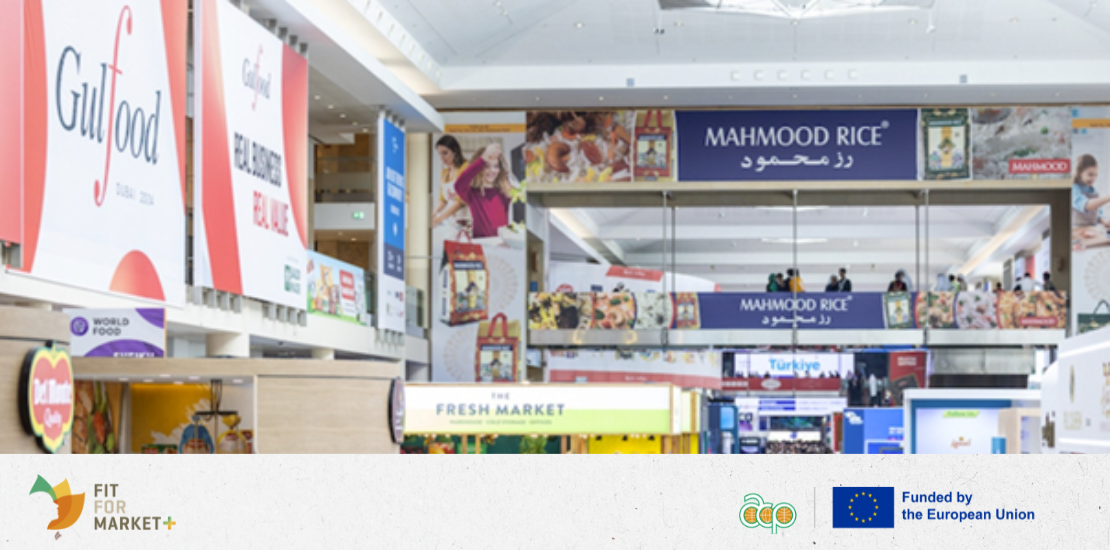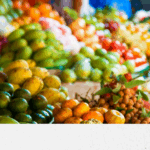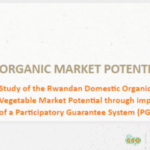- 06/05/2025
- Posted by: Sandra Borma
- Category: News

This article is based on observations and meetings made by the COLEAD team in Dubai during the show last February. The mission has been implemented through the Fit For Market Plus programme.
A world-class show, but with a still limited African presence
Gulfood is the largest food exhibition in the Middle East, attracting more than 5,500 exhibitors from around 130 countries. The last edition took place in Dubai in February 2025. Every year it brings together companies from all over the world, not only to sell to the Middle East, but also to establish global business contacts. This year, the African continent was noticeably under-represented, with only two South African exhibitors, one Ethiopian and one Madagascan. This absence is difficult to explain, but could be due to competition from the European shows Fruit Logistica and BIOFACH, a lack of awareness of the event or difficulties in accessing it. What is certain is that the potential for commercial opportunities appears to be largely untapped.
Middle East markets: potential and constraints
The exhibition gave us a deeper understanding of the Middle Eastern agri-food markets, which vary greatly from country to country. Among other, the following observations were made:
- The United Arab Emirates offers an easy entry point to the region;
- Saudi Arabia is becoming increasingly attractive thanks to the development of tourism ;
- The market in Kuwait seems more difficult to reach ;
- Oman has strict regulations for fresh fruit and vegetables.
In this region, commercial practices often require payment in advance and it is advisable to take out insurance against fraud. Using a reliable local partner and having a local presence are key elements for success.
The processed fruit and vegetable market is highly competitive and price sensitive and is dominated by China, India and Turkey. The only identified niches are high-end products such as IQF (Individually Quick Frozen) fruit and innovative juice blends.
African products already on the shelves
Despite their absence from the show, many fresh products of African origin are well represented in local premium stores: pineapples, avocados, strawberries, lychees, broccoli, citrus fruits, grapes, fresh dates and baby vegetables, mainly from Kenya, Tanzania, Namibia, South Africa, Madagascar and Ethiopia.
Product trends and innovations
Three main consumer trends were identified
- Health: nutritious, protein-rich snacks with collagen or probiotics.
- Nostalgia: a return to familiar, comforting flavours.
- Sustainability: the growing importance of environmental impact in consumer choice.
Some notable product innovations spotted at the show:
- Pinkglow, Honeyglow and Rubyglow pineapples (Del Monte): pink flesh, red skin… but not approved in the EU due to genetic modification.
- Tropical fruit avocado spreads: a bold combination of creamy texture and sweet and tangy flavours.
- Vegan coconut and mango puree snacks (Yourharvest, Switzerland), winners in their category.
- Yook’s Mango Oat Milk, sweetened only with fruit, winner in the health category.
This activity is supported by the Fit For Market Plus (FFM+) programme, implemented by COLEAD within the Framework of Development Cooperation between the Organisation of African, Caribbean and Pacific States (OACPS) and the European Union. This publication receives financial support from the European Union and the OACPS. The content of this publication is the sole responsibility of COLEAD and can in no way be taken to reflect the views of the European Union or the OACPS.





